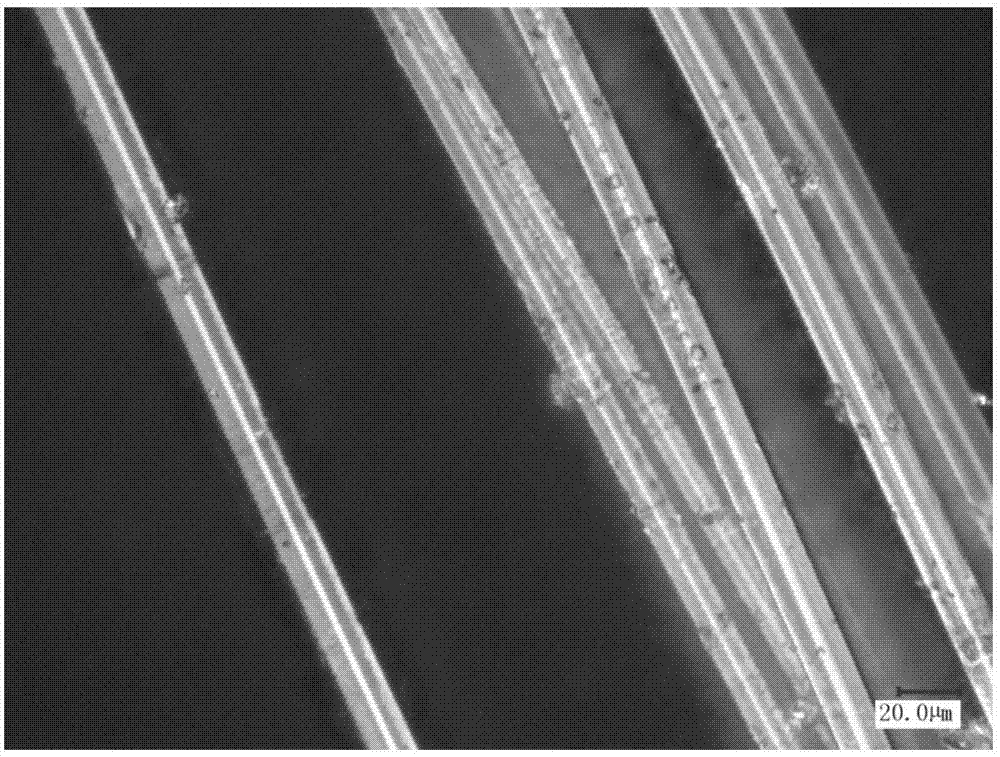Progressive decarbonizing method of nitride fiber
A nitride and progressive technology, applied in the fields of fiber chemical characteristics, textiles and papermaking, etc., can solve the problems of fiber nano-scale damage, low ammonia utilization rate, affecting fiber mechanical properties, etc., achieve small ammonia consumption and improve Mechanical properties, the effect of improving utilization
- Summary
- Abstract
- Description
- Claims
- Application Information
AI Technical Summary
Problems solved by technology
Method used
Image
Examples
Embodiment 1
[0024] (1) Place 100 grams of polysilazane fiber samples in a high-temperature graphite furnace with a fiber monofilament diameter of 15 microns, vacuumize and replace high-purity nitrogen, and repeat twice; The room temperature was raised to 300°C, and high-purity ammonia gas was introduced at a flow rate of 5L / min, the pressure in the furnace was maintained at 0.2MPa, and the temperature was continued to rise to 650°C at 1°C / min, and a total of 1250L of high-purity ammonia gas was introduced; (3 ) Continue to heat up to 650°C at a heating rate of 1°C / min, stop feeding ammonia, and feed high-purity nitrogen at a flow rate of 10L / min, and heat up to 950°C at 1°C / min; 4) Continue at 5°C / min Raise the temperature to 1200°C and keep it warm for 2 hours to obtain silicon nitride ceramic fiber. The super depth-of-field microscope photo of the fiber shows that the nitride fiber is smooth and dense. GPa, elastic modulus 181GPa.
[0025] The ultra-depth-of-field microscope photo of g...
Embodiment 2
[0028] (1) Place 100 grams of polyborazane fiber samples in a high-temperature graphite furnace with a fiber monofilament diameter of 12 microns, vacuumize and replace high-purity nitrogen, and repeat twice; The room temperature was raised to 450°C, and high-purity ammonia gas was introduced at a flow rate of 10L / min, the pressure in the furnace was maintained at 0.3MPa, and the temperature was continued to rise to 650°C at 1°C / min, and a total of 1000L of high-purity ammonia gas was introduced; (3 ) stop feeding ammonia at 650°C, feed high-purity nitrogen at a flow rate of 5L / min, and raise the temperature to 950°C at 0.2°C / min; The boron nitride ceramic fiber can be obtained, the carbon content is 0.25wt%, the monofilament strength is 1.75GPa, and the elastic modulus is 156GPa.
Embodiment 3
[0030] (1) Place 100 grams of polyborosilazane fiber samples in a high-temperature graphite furnace with a fiber filament diameter of 13 microns, vacuumize and replace high-purity nitrogen, and repeat twice; (2) According to the heating rate of 1 ° C / min Raise the temperature from room temperature to 400°C, start feeding high-purity ammonia gas at a flow rate of 10L / min, keep the pressure in the furnace at 0.4MPa, continue to heat up to 650°C at 0.5°C / min, and feed a total of 2500L of high-purity ammonia gas; ( 3) Stop feeding ammonia gas at 650°C, feed high-purity nitrogen gas at a flow rate of 5L / min, and raise the temperature to 950°C at a rate of 0.5°C / min; The SiBN ceramic fiber can be obtained, the carbon content is 0.28wt%, the monofilament strength is 1.80GPa, and the elastic modulus is 165GPa.
PUM
| Property | Measurement | Unit |
|---|---|---|
| diameter | aaaaa | aaaaa |
| strength | aaaaa | aaaaa |
| elastic modulus | aaaaa | aaaaa |
Abstract
Description
Claims
Application Information
 Login to View More
Login to View More - R&D
- Intellectual Property
- Life Sciences
- Materials
- Tech Scout
- Unparalleled Data Quality
- Higher Quality Content
- 60% Fewer Hallucinations
Browse by: Latest US Patents, China's latest patents, Technical Efficacy Thesaurus, Application Domain, Technology Topic, Popular Technical Reports.
© 2025 PatSnap. All rights reserved.Legal|Privacy policy|Modern Slavery Act Transparency Statement|Sitemap|About US| Contact US: help@patsnap.com


